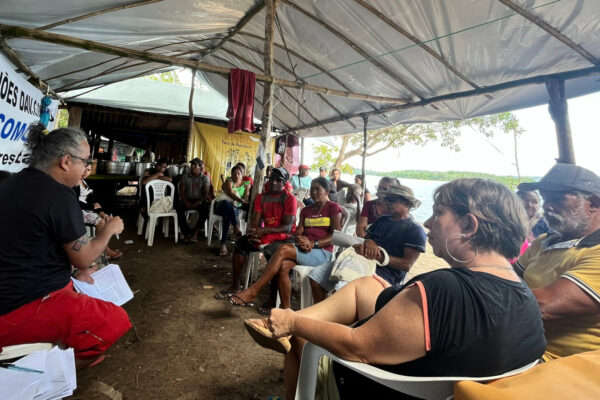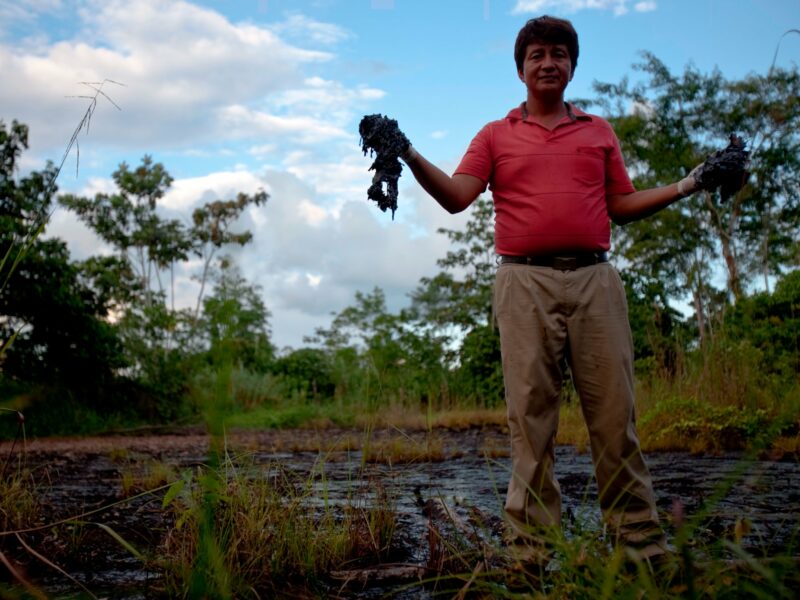Lago Agrio, Ecuador – ChevronTexaco will face off against indigenous Ecuadorians in an Ecuadorian court and the stakes are massive. On May 6th, attorneys representing more than 30,000 Ecuadorian rainforest peoples will file suit in Lago Agrio, a small oil town in the heart of Ecuador’s Oriente region, charging the petroleum giant with systematically destroying their homeland through massive dumping of highly toxic wastewater and crude oil over the two decades of the company’s operations in Ecuador.
This case is being closely watched by legal scholars and attorneys because of the potential standard it might set for U.S.-based multinational corporations operating in developing countries. (See statement in press packet of Alejandro Garro, Professor of Comparative and Latin American Law, Columbia University).
“This case has the potential to establish a new accountability for U.S. oil companies that think they can operate abroad without adhering to responsible environmental practices,” says Cristobal Bonifaz, a lead attorney for the plaintiffs. “On the face of it, this is a ‘David versus Goliath’ battle. However, the United States court has leveled the playing field by ruling that a small court in a remote town of Ecuador has the same power over a $99 billion multinational corporation as a federal court in Manhattan. This alone is a breakthrough.”
After nearly ten years of legal proceedings, the U.S. Second Circuit Court of Appeals ruled in August 2002 that the Ecuadorian judicial system has primary jurisdiction for this case – and, most significantly, that its ruling and whatever financial penalty imposed on ChevronTexaco would be enforceable in the United States. For years, ChevronTexaco had fought to avoid being subject to jurisdiction in Ecuador, fearing the uncertainty of litigation in a country where foreign control over oil resources has become a contentious issue for indigenous groups, which constitute the largest bloc of voters in Ecuador. (Ecuador recently elected its first indigenous president, Lucio Gutierrez, and has one of the largest indigenous populations in Latin America. The country also has Latin America’s first indigenous foreign minister, Nina Pacari.)
During its two decades of operations in Ecuador (from 1971 to 1992), Texaco (now ChevronTexaco) dumped more than 50% more oil into the rainforest environment than that spilled during the Exxon Valdez disaster off the coast of Alaska, which resulted in a $5 billion judgment after a jury trial. At the height of its operations in Ecuador, ChevronTexaco was dumping some 4.3 million gallons per day of toxic oil wastewater into open pits, estuaries, and rivers (this wastewater contains 500 to 5000 parts per million of pure oil as well as cancer-causing heavy metals). The total amount of wastewater dumped into Ecuador’s rainforest was 464,766,540 barrels, or roughly 18.5 billion gallons (one barrel contains 40 gallons).
ChevronTexaco also left behind approximately 350 open waste pits contaminated with heavy metals and other carcinogenic compounds, some of which exist only a few feet from the homes of residents. The company concedes it dumped the oil and left the open waste pits, but asserts little harm was caused and that some of the waste has been adequately remediated – a claim vigorously disputed by the plaintiffs and their lawyers.
This case is being filed at a time when U.S. companies operating in Latin America are being subject to increased legal exposure for causing environmental damage. In January of this year, a Nicaragua court ordered Shell, Dole and Dow to pay $489.4 million to 450 workers exposed to a pesticide that rendered them impotent (the companies thus far have refused to pay). Other companies recently targeted by “class action style” environmental litigation in Latin America include Dole Food, Shell Oil, Dow Chemical, Occidental Chemical, Del Monte Fresh Produce and Chiquita Brands International.
“We believe that what ChevronTexaco did in the Ecuador rainforest was not only negligent, but might rise to the level of reckless behavior,” says Joseph Kohn, a lead attorney for the plaintiffs and a partner in Kohn, Swift & Graf, a leading class-action firm based in Philadelphia. “The company does not dispute that it deliberately dumped poisons into the ground and waterways to save money. They claim it was fine because it did not violate any of Ecuador’s laws at the time. But at the time, Ecuador had no environmental laws governing oil extraction because it had no oil industry. The company took advantage.”
Adds Kohn, “This is one of the first environmental cases where a U.S. company will be forced to defend itself in a foreign country for actions committed on that country’s soil and the ruling and judgment will be enforceable by the U.S. courts.”
Adding to the stakes is that in 1999 ChevronTexaco purchased a 50% interest in an exploration bloc in a region of the Ecuadorian Amazon close to where the previous damage occurred. Protests over the purchase erupted in the local indigenous communities and the company has since sold the stake. Several indigenous leaders in Ecuador’s Amazon have said they fear that ChevronTexaco wants to resume drilling in the country, which has the third largest oil reserves in Latin America (after Venezuela and Mexico) and is auctioning off several exploration blocs to alleviate its crushing debt burden.
For the indigenous people and the campesinos of the Oriente, it has been a long and winding road in search of justice.
The suit alleges that ChevronTexaco engaged in “negligent, reckless, deliberate, and outrageous acts” in the Ecuadorian Amazon by refusing to adhere to accepted standards of the oil industry to clean up and dispose of toxic waste from drilling. In order to further increase its already-hefty profits, ChevronTexaco simply dumped the toxic wastes from its wells into the 350 man-made waste pits rather than reinject them back underground, which is the accepted industry practice in the U.S. and around the world. The lawyers assert that about $4.5 billion of the company’s profits from Ecuador – or an estimated $3 per barrel for the 1.5 billion barrels extracted – represents a form of “unjust enrichment” that resulted directly from the decision to dump the waste water rather than install reinjection technology.
ChevronTexaco’s open waste pits filled with oil muck now blanket Ecuador’s northern Amazon region. Much of the toxins in these pits have leeched into the groundwater and rivers, which residents rely on for drinking water and bathing (there is no running water in almost all villages in the region). It is not unusual to see carcasses of farm animals, such as cows and goats, mired in the pits. The London School of Epidemiology found one small community of several hundred residents had reported ten deaths from cancer in only a few years, including one child who was only five years old (See Fact Sheet on San Carlos Study). These rates of cancer were many times the historical norms – the rate of larynx cancer, for example, was found to be 30 times higher than the norm for males.
“The real tragedy is ChevronTexaco could have done the right thing by installing proper reinjection technology when they got to Ecuador,” says Bonifaz. “They still could have made enormous profits without polluting.”
Although the full scope of the public health impact awaits a comprehensive study, several focused studies on aspects of the pollution point to serious and even deadly consequences. Samples from the open waste pits have found some of the most cancer-causing chemicals known to man, including Benzene, Toluene, Arsenic Lead, Mercury and Cadmium. Studies by a Harvard medical team and Ecuadorian health authorities have found unusually high incidences of eight types of cancer in communities affected by ChevronTexaco’s operations: bile duct, stomach, larynx, liver, melanoma, leukemia, lymphoma, and cervical.
The lawsuit also charges that when the open pits filled up, the company regularly discharged the contents into the Amazon wetlands. The contamination was compounded by ChevronTexaco’s practice of siphoning oil from the pits into large tanker-trucks, which then sprayed it along hundreds of miles of dirt roads that pass in front of houses and farming land in order to keep the dust down during the dry season. The suit also alleges that ChevronTexaco deliberately set the oil pits on fire.
According to the plaintiffs and their lawyers, the toxic tragedy has exacted a staggering toll:
· Several indigenous tribes – including the Cofan, Secoya and Siona – have been hard-hit, with their cultures on the brink of collapse. These tribes subsisted for centuries by drinking water from the rivers and eating fish caught in the rivers. Most of the rivers are so polluted that the tribal members have been forced to abandon their ancestral lands;
· The Cofan People, who in 1971 had ChevronTexaco’s first well built on their territory and who at one point numbered 15,000, have seen their population dwindle to less than 300;
· Dozens of people, including many women and children, have contracted cancer as a result of contact with the poisons, and thousands more are subject to an increased risk of contracting cancer;
· 2.5 million acres of pristine rainforest have been lost along the route of the pipelines and wells Texaco built in 1972;
· 20 billion gallons of highly toxic wastewater has been dumped into the waterways, rendering them undrinkable.
“ChevronTexaco came to our home in Ecuador more than thirty years ago promising hope but ended up giving us nothing but misery,” says Luis Yanza, a community organizer for the Frente de Defensa de Amazonía, which represents many of the affected communities. “Our people see it as an environmental crime of epic proportions.”
At a time of renewed scrutiny of corporate accountability, ChevronTexaco has thus far almost unilaterally escaped its financial obligation to ameliorate its destruction. The company claims it contributed $40 million towards an environmental cleanup cost that is widely valued well in excess of $1 billion. However, residents of the region claim that most of this sum lined the coffers of local governments and officials, and that only a tiny portion was actually spent on the clean up.
The case commenced in 1993, when Ecuadorian plaintiffs representing 30,000 indigenous people and campesinos filed a class-action lawsuit against Texaco in U.S. federal court in New York (Texaco’s headquarters, and where the decision to drill in Ecuador was made, is in White Plains, NY). The case was the first environmental lawsuit ever filed in the U.S. by foreign plaintiffs alleging that a U.S. corporation violated the law of nations by causing pollution abroad. At numerous junctures, ChevronTexaco sought to have the case dismissed, claiming that Ecuador was the more appropriate venue. The company’s legal strategy was to have the case moved to Ecuador, where it could then claim the courts had no jurisdiction over ChevronTexaco because it no longer had operations there. The recent decision of the U.S. federal court forced the company to submit to jurisdiction in Ecuador or face trial in the U.S. Given the choice, the company finally agreed to jurisdiction in Ecuador. The New York judge did not reach a decision on the merits of the case.
ChevronTexaco’s Ecuadorian operations have for years haunted the company from a public relations standpoint. AmazonWatch, an environmental organization based in California, has targeted the company to force it to clean up the contamination, and plans on bringing a delegation of indigenous leaders from Ecuador to company headquarters in San Ramon, CA, in the days after the lawsuit is filed. The delegation plans on engaging in a series of public education seminars for town residents and company employees.
Lead attorneys for the Ecuadorians include Cristobal Bonifaz, an Ecuadorian-born attorney practicing in Amherst, Massachusetts; Joseph Kohn, of the law firm of Kohn, Swift & Graf, a leading class-action firm in the U.S., based in Philadelphia; Steven Donziger, a New York-based litigator; John Bonifaz, a Boston-based lawyer; and, Alberto Wray, a prominent Ecuadorian legal scholar and former member of Ecuador’s Supreme Court.













